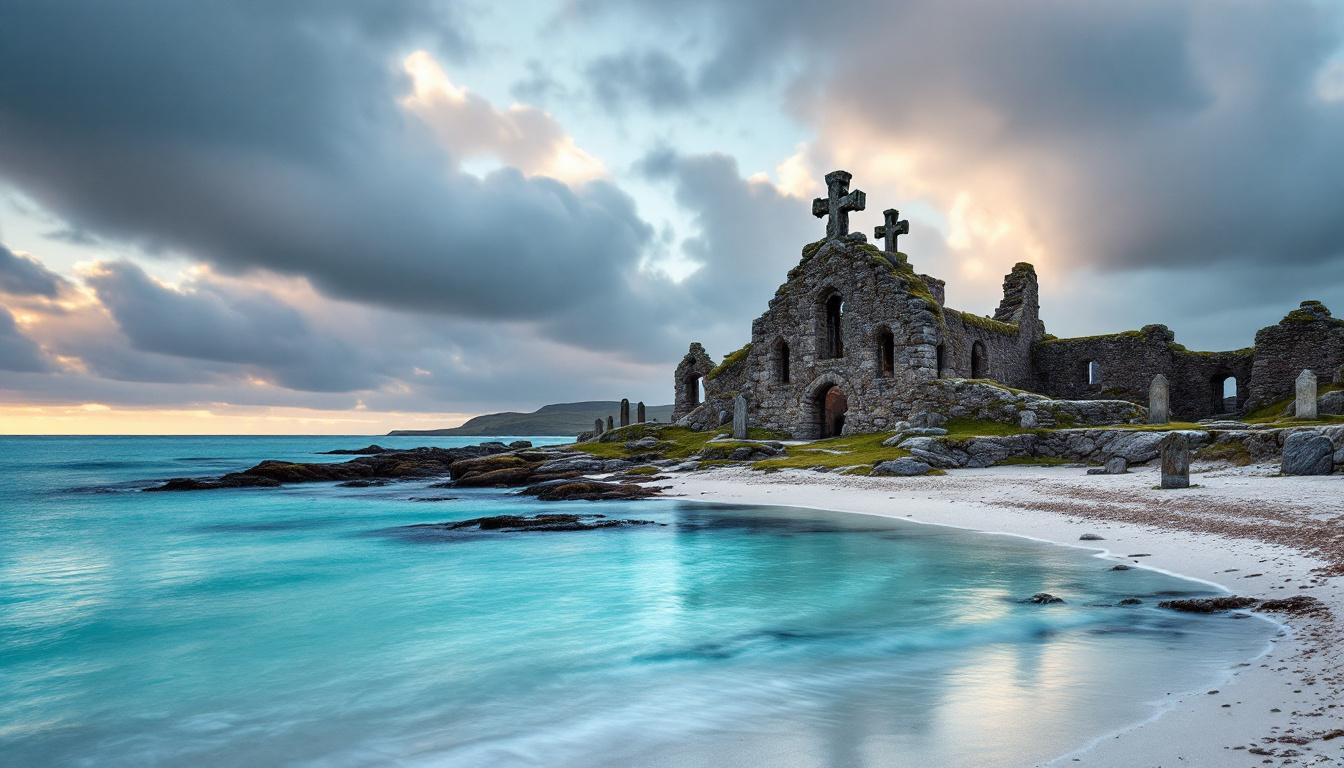Sixty Scottish kings rest beneath waters so turquoise they rival the Caribbean, yet you’ve probably never heard of this sacred island. Iona is the only place on Earth where ancient royal tombs meet tropical-hued seas in a living Christian sanctuary that’s remained unchanged for 1,400 years.
This three-mile stretch of the Inner Hebrides holds more crowned heads than Westminster Abbey, yet receives a fraction of the visitors. While 130,000 people annually discover this spiritual treasure, it remains Scotland’s most exclusive royal burial ground.
What makes Iona utterly unique isn’t just its collection of monarchs or its stunning waters—it’s the only destination where you can walk among the graves of Kenneth MacAlpin, Duncan I, and Macbeth while gazing at seas that appear lifted from a tropical postcard.
The royal necropolis hidden in plain sight
Where Scottish monarchy began its eternal rest
Reilig Odhráin, Iona’s ancient cemetery, cradles the remains of 48 Scottish kings alongside 8 Norwegian and 4 Irish rulers. This humble graveyard predates every other royal burial site in Scotland, making it the original resting place of Celtic monarchy. Archaeological evidence confirms burials from the 9th to 11th centuries, though no monuments mark these sacred graves.
The kings who shaped Scottish history
Kenneth MacAlpin, the first King of Scots who united the Picts and Scots in 843 AD, chose Iona as his eternal home. Duncan I and his successor Macbeth—immortalized by Shakespeare—both found peace in this windswept cemetery. Unlike the grandiose tombs of later monarchs, these kings rest in simple graves, their power measured not in marble but in the island’s enduring spiritual significance.
Turquoise waters that defy Scottish expectations
The optical phenomenon creating Caribbean colors
Iona’s waters shimmer in shades of turquoise and aquamarine thanks to rock flour—glacial particles suspended in the sea that scatter light into tropical hues. This natural phenomenon occurs when quartz-rich sediments from ancient glacial erosion create the perfect conditions for light refraction, producing colors more associated with Barbados than Scotland.
Why July reveals the most spectacular displays
Summer’s extended daylight hours and calmer seas allow these optical effects to reach their peak intensity. The white quartz beaches reflect additional light into the water, creating an almost surreal contrast against Scotland’s grey skies. Photography enthusiasts consistently rank Iona’s July waters among Europe’s most unexpectedly beautiful coastal scenes.
The living Christian sanctuary that never stopped
Fifteen centuries of unbroken spiritual practice
Since St. Columba established his monastery in 563 AD, Iona has maintained continuous Christian worship—making it the only royal burial site with an active spiritual community. The Iona Community conducts weekly services in the restored abbey, where pilgrims participate in liturgies that echo through 1,400 years of uninterrupted devotion.
Modern pilgrimage in an ancient setting
Unlike commercialized religious sites, Iona’s spiritual programs focus on contemplation and community service. Visitors can join guided reflections at St. Oran’s Chapel, participate in environmental restoration projects, or simply experience the profound silence that has drawn seekers for millennia. The island’s 170 residents maintain this sacred atmosphere through careful visitor management.
Accessing Scotland’s most exclusive royal destination
The journey that preserves authenticity
Reaching Iona requires dedication—first a ferry to Mull, then a smaller vessel carrying foot passengers only. This controlled access naturally limits crowds while preserving the island’s contemplative atmosphere. July’s mild temperatures and extended daylight make the journey particularly rewarding, though advance accommodation booking is essential given the island’s limited guesthouses.
Why exclusivity enhances the experience
The absence of cars and tour buses creates an almost medieval tranquility. Visitors walk the same paths as ancient pilgrims, experiencing the island much as those Scottish kings would have known it. This isolation isn’t accidental—it’s how Iona has maintained its authentic character while other historic sites succumb to commercialization.
No other destination offers this extraordinary combination of royal history, natural beauty, and living spirituality. Iona stands alone as the only place where ancient Scottish monarchy, Caribbean-colored seas, and 1,400 years of Christian devotion converge in perfect harmony.
Plan your pilgrimage for July when the turquoise waters reach their most brilliant intensity, and join the exclusive company of kings, saints, and seekers who have found something irreplaceable on this sacred island.
